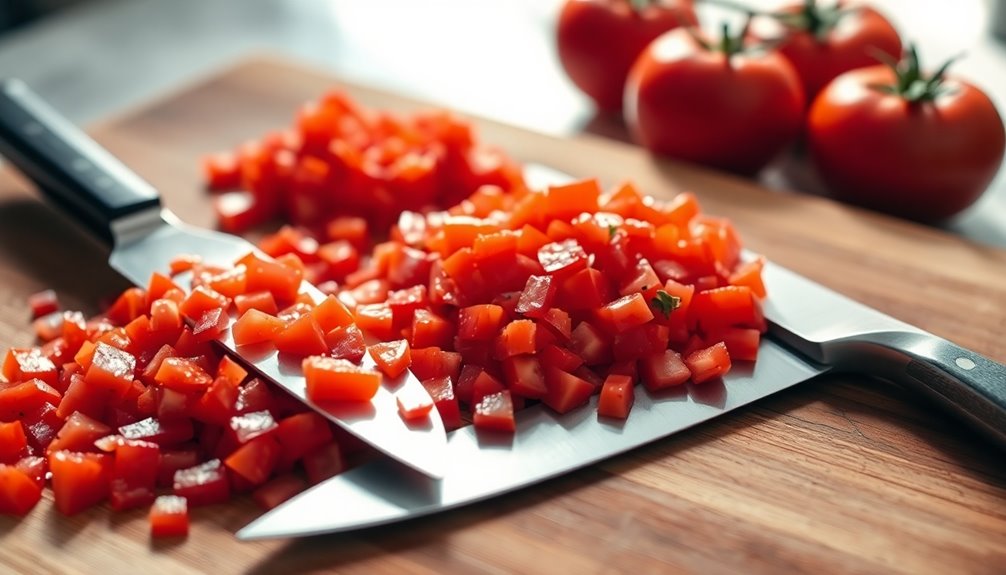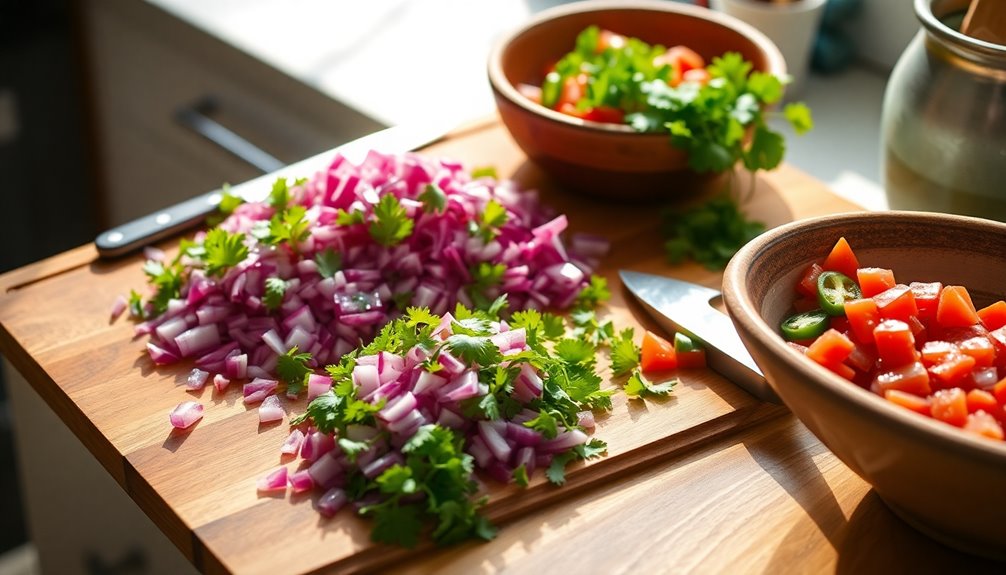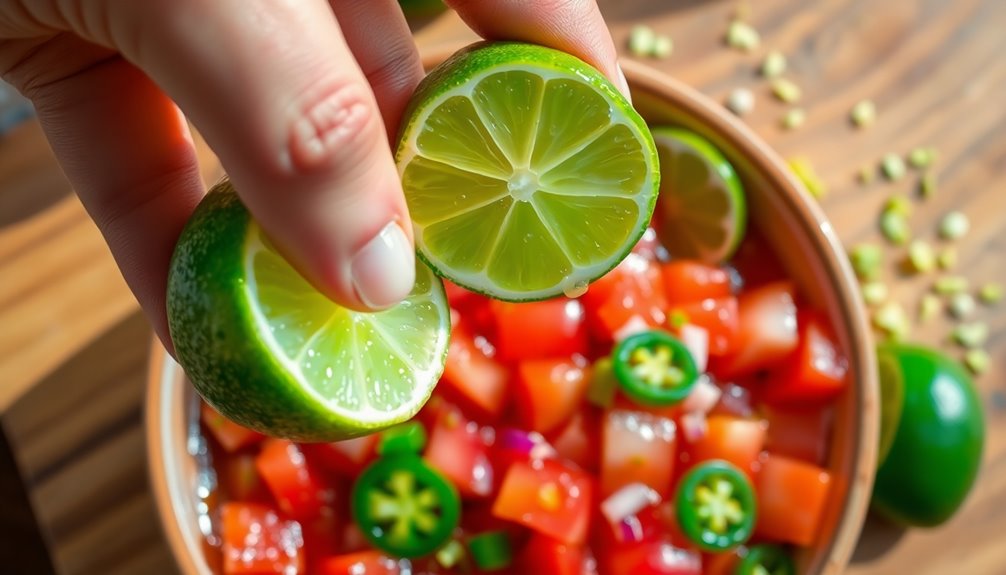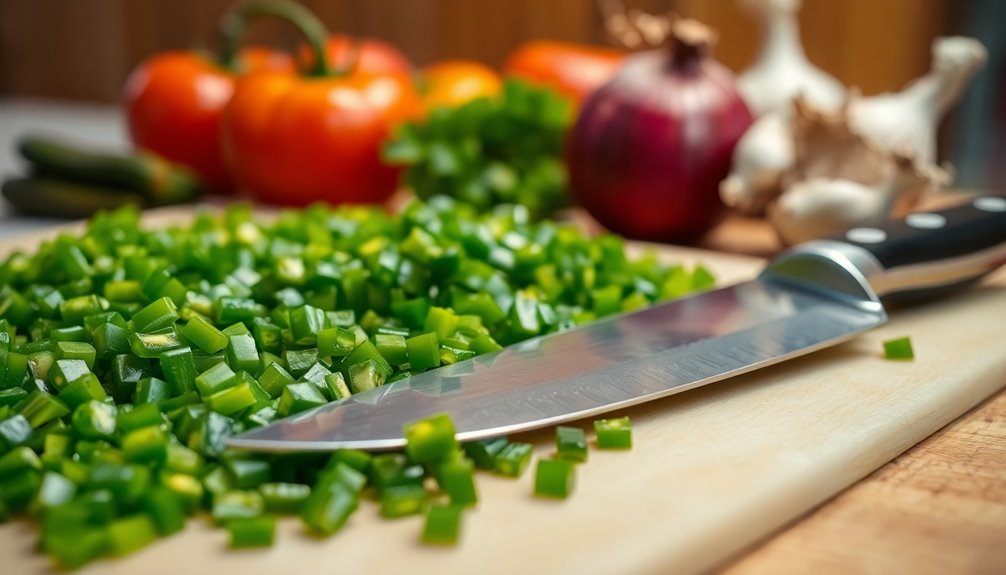When you think about salsa, it's easy to overlook its rich history and the nuances that can elevate a simple recipe into something remarkable. You might start with basic ingredients like tomatoes and onions, but the secret often lies in the details, such as the type of peppers or the method of preparation. As you explore different variations, you'll discover how small adjustments can significantly impact flavor and texture. What you might not expect is how these elements intertwine to create a salsa that reflects both tradition and personal taste.
Key Takeaways
- Combine 4 chopped ripe tomatoes, 1 diced red onion, and 3 minced garlic cloves for a flavorful base.
- Adjust heat with 3 jalapeños, removing seeds for milder salsa, or substitute with bell peppers.
- Mix in 15 oz crushed San Marzano tomatoes and 4.5 oz diced green chiles for added texture.
- Enhance flavors with fresh cilantro, lime juice, salt, and optional sugar to balance taste.
- Allow salsa to rest for 30 minutes before serving to meld the flavors effectively.
History

Salsa has a rich history that dates back to the Aztec civilization, where it was crafted using tomatoes, chili peppers, and ground spices. This vibrant sauce, meaning "sauce" in Spanish, has evolved over the centuries.
By the 1980s, it gained immense popularity in the United States alongside the rise of Mexican cuisine. You might enjoy the fresh variations, like pico de gallo or salsa verde, which highlight ingredients such as cilantro and lime juice. As this culinary trend expanded, many households began incorporating traditional dishes into their weekly meals. Authentic Mexican rice preparation became a cherished skill, allowing families to serve flavorful side dishes that complemented their main courses. This emphasis on fresh, vibrant ingredients not only enhanced the dining experience but also fostered a greater appreciation for the rich diversity of Mexican cuisine.
The beauty of salsa lies in its adaptability; you can adjust the heat with jalapeños or customize it with your favorite ingredients.
Today, salsa has surpassed ketchup as a beloved condiment, showcasing its enduring appeal and versatility in homemade recipes.
Recipe

Making homemade salsa is a simple yet rewarding culinary endeavor that brings fresh flavors to your table. Whether you're preparing for a gathering or simply want to elevate your snack game, this salsa recipe delivers a perfect balance of freshness and heat. With just a handful of ingredients, you can create a vibrant dip that pairs wonderfully with tortilla chips, tacos, or grilled meats.
The key to a great salsa lies in the quality of your ingredients, particularly the tomatoes and jalapeños, which impart their unique flavors to the mix. To achieve the best results, it's recommended to use ripe, in-season tomatoes for their sweetness and juiciness. The addition of red onion and garlic enhances the salsa's complexity, while jalapeños provide a delightful kick. Including ingredients like chia seeds can also boost the nutritional profile of your dishes, contributing to digestive health.
The recipe allows for adjustments in spice levels, making it suitable for all palates. Once prepared, letting the salsa rest in the refrigerator allows the flavors to meld beautifully, creating a truly delicious condiment.
Ingredients:
- 4 ripe tomatoes
- 1 red onion
- 3 garlic cloves
- 3 jalapeños
- 15 oz crushed San Marzano tomatoes
- 4.5 oz diced green chiles
- Salt to taste
Instructions:
Begin by dicing the ripe tomatoes, red onion, jalapeños (removing seeds for less heat if desired), and mincing the garlic cloves. In a large mixing bowl, combine the fresh ingredients with the crushed San Marzano tomatoes and diced green chiles.
Stir thoroughly to ensure an even distribution of flavors. Once combined, season with salt to taste. It's best to let the salsa sit in the refrigerator for at least 30 minutes before serving to allow the flavors to develop.
Extra Tips:
For an added depth of flavor, consider roasting the jalapeños and garlic before adding them to the mix. This can bring out a smokier taste that enhances the overall profile of your salsa.
If you find your salsa too spicy, you can add a bit of sugar to balance out the heat. Lastly, remember that homemade salsa can be stored in an airtight container in the fridge for up to 10-12 days, making it an excellent option for meal prep or last-minute party snacks.
Cooking Steps

To kick off your salsa, start by chopping fresh tomatoes finely and mixing in some chopped onions and cilantro.
Squeeze in a generous amount of lime juice, then add diced jalapeños to bring the heat.
Finally, season it all with salt to taste for that perfect flavor balance.
Step 1. Chop Fresh Tomatoes Finely

Start by rinsing and coring the fresh tomatoes, then cut them into quarters for easier handling.
Using a sharp knife and cutting board, slice the tomato quarters into thin strips before dicing them into small, uniform pieces.
For the best results in your fresh salsa recipe, you might want to remove excess seeds and juice, which helps prevent a watery salsa.
Aim for a consistent size when chopping to ensure even blending and enhance the salsa's texture.
If you're using Roma tomatoes, their lower water content makes for a firmer chop, perfect for your homemade salsa recipe.
Once you have your chopped fresh tomatoes, you'll be well on your way to making easy salsa that bursts with fresh flavor!
Step 2. Add Chopped Onions and Cilantro

Now that you've finely chopped your fresh tomatoes, it's time to enhance your salsa with chopped onions and cilantro.
Start by finely chopping 1 red onion and soaking it in cold water for about 10 minutes. This helps reduce its raw bite, making it easier to enjoy in your fresh tomato salsa recipe.
Next, add 1 cup of freshly chopped cilantro to introduce a vibrant herbaceous note. This ensures maximum freshness and elevates the overall flavor profile.
Combine the chopped onion and cilantro evenly into the salsa mixture, adjusting the onion quantity to suit your taste preference. This step is crucial for achieving a balanced taste, allowing the onion flavor and fresh herbs to complement each other perfectly.
Step 3. Add Lime Juice Generously

While you're mixing in the chopped onions and cilantro, it's essential to add lime juice generously to elevate the flavor of your salsa.
Fresh lime juice brings the perfect acidity, balancing the sweetness from the tomatoes and enhancing the overall flavor profile. Aim for the juice of 1 to 2 limes, adjusting based on your taste preference.
This citrus flavor not only brightens the salsa but also helps preserve its freshness, keeping it vibrant for up to 5 days in the refrigerator.
For an extra kick, consider incorporating lime zest, which intensifies that refreshing citrus aroma.
With the right amount of lime juice, your salsa will be zesty and ready to complement the heat from the jalapeños beautifully.
Step 4. Add Diced Jalapeños for Heat

To give your salsa that perfect kick, add diced jalapeños for heat. Start with 1 to 2 medium peppers, adjusting based on your desired spice level.
For a milder taste, remove the seeds and membrane, which significantly reduces their heat while keeping the flavor intact. Finely mince the jalapeños to ensure even distribution throughout your salsa, enhancing its overall flavor profile.
Before adding them, taste the jalapeños, as some can be spicier than others depending on their ripeness and variety.
If you're feeling adventurous, consider adding extra peppers like serrano or habanero for an additional spicy kick, but make sure to balance their heat with the other ingredients in your salsa.
Enjoy the zesty results!
Step 5. Season With Salt to Taste

Seasoning your salsa with salt is essential for bringing out the natural flavors of the ingredients. Start with about 1/2 teaspoon of salt, then gradually add more, tasting as you go. This way, you can avoid over-salting while enhancing the taste of your salsa.
Salt not only boosts the flavors but also balances the acidity from the tomatoes and lime juice, creating a well-rounded dish. For the best results, consider using freshly ground sea salt or kosher salt, as they provide a more vibrant flavor.
After seasoning, let your salsa rest for at least 30 minutes. This resting period allows the flavors to meld, resulting in a delicious and harmonious salsa that's ready to impress.
Final Thoughts

Making your own salsa not only elevates your dishes but also allows you to tailor the flavors to your liking. This homemade salsa recipe, featuring fresh Roma tomatoes, onion, and jalapeños, is quick to prepare, taking just 5 minutes.
You can easily adjust the spice level by modifying the jalapeños to suit your taste. For optimal flavor blending, remember to refrigerate the salsa for a bit before serving.
Store it in an airtight container, where it'll last 10-12 days in the fridge. If you have leftovers, consider freezing salsa for up to 4 months, though the texture may change upon thawing.
Enjoy the satisfaction of creating a salsa that perfectly complements your meals!










